.NET Tools
Essential productivity kit for .NET and game developers
ReSharper Ultimate 2016.3 is Released!
We have just finalized an update to ReSharper Ultimate, and we invite you to check out what’s new and download ReSharper Ultimate 2016.3 RTM!
Watch the following video for a summary of what is new in ReSharper Ultimate 2016.3, or read on for the main highlights of this release:
ReSharper
In addition to 700+ fixes, major highlights of ReSharper 2016.3 are the following:
- Visual Studio 2017 RC initial support. All ReSharper Ultimate tools now support Visual Studio 2017 RC, including the new .csproj based .NET Core projects. Please note that though Visual Studio 2017 is marked as “RC” there are a number of features and architectural changes that are currently marked as “preview”. As such, we are still working on support for some of these new Visual Studio features, such as lightweight solution load and .NET Core unit testing.
- Early support for C# 7 and VB.NET 15. ReSharper 2016.3 learns to understand VB.NET 15 and C# 7 binary literals and digit separators. C# 7 local functions are supported with a set of code inspections, such as Possible System.NullReferenceException, Access to disposed closure, and Access to modified closure. C# 7 out variables, pattern-matching in
isexpressions andswitchcases are also supported.

- New code generation actions. Generate Relational members action helps you automatically overload relational operators (
>,<,≥,≤) and/or implementIComparableandIComparable<T>using selected fields and properties. Generate Relational comparer creates a comparer class derived fromComparerusing selected fields and properties. Generate Dispose pattern action helps you generate the implementation ofIDisposablewith optional nullability checks and destructor for unmanaged members.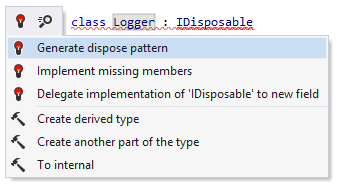
- New quick-fixes and context actions. ReSharper 2016.3 adds a new quick-fix to Introduce fields and auto properties from all unused parameters. This is an extension to the existing quick-fix that will introduce a field from a single constructor parameter, but if you extend the Alt+Enter menu item, it will now apply to all unused parameters at once.

The Introduce property quick-fix also includes a Configure default menu item, which will set what kind of property is generated by default. There's also a new context action on fields of typeLazyto introduce a property to encapsulatefieldname.Value. - New Transform Parameters refactoring is based on two existing refactorings: Transform Out Parameter and Extract Class from Parameters. It can be invoked on a method declaration and will rewrite the method’s parameters, changing incoming parameters to a new class, or a tuple, and optionally creating a new class for return value and any out parameters.
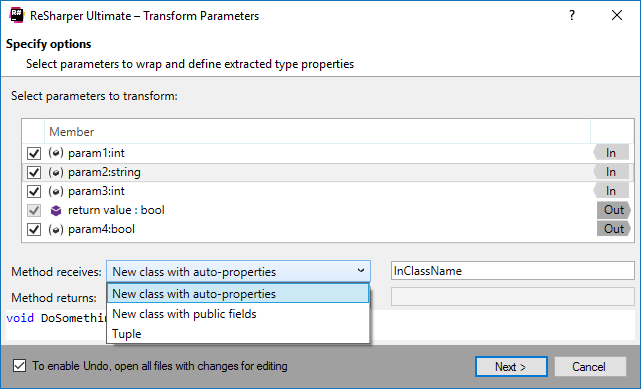
- ReSharper's unit testing assistance is now available for NUnit and xUnit.net unit tests in ASP.NET Core and .NET Core projects in Visual Studio 2015.
- Navigation and search improvements:
- The Find Results window now works asynchronously, meaning that you can work with the results tree while usage search is still in progress. The Show in Find Results button becomes available in the pop-up as soon as you invoke Usages of Symbol (Shift+Alt+F12). So you can just click it or press + to go on working with the code while the search continues in the Find Results window.

- Recent Files can now delete entries with the Delete key, and both the Recent Files and Recent Edits pop-ups will now show the path of the file, to avoid confusion with similarly named files.
- Go to Text now supports new formats of content files, such as .less, .hbs, .coffee, .scss, .dart, .as, .styl.
- There is a new setting to remember the last search in Go to Everything, Go to Text and other search actions.
- The Find Results window now works asynchronously, meaning that you can work with the results tree while usage search is still in progress. The Show in Find Results button becomes available in the pop-up as soon as you invoke Usages of Symbol (Shift+Alt+F12). So you can just click it or press + to go on working with the code while the search continues in the Find Results window.
- ReSharper Build receives its own Build Results window, which lists build warnings and errors. You also get more control over how you want to see the results. You can see them as a flat list, or enable grouping, to show by a mixture of project, folder and file. Or you can use ReSharper’s semantic knowledge of the file to group by namespace, type and member.
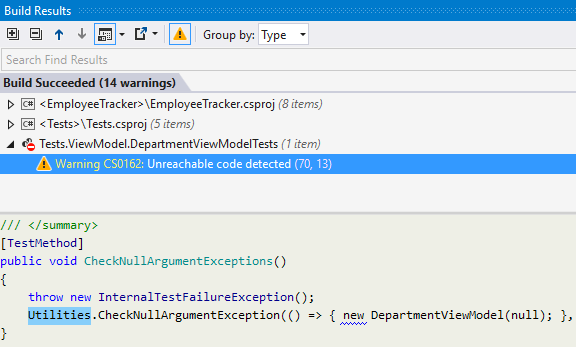
Moreover, ReSharper Build now gets its own implementation of NuGet restore. - TypeScript, JavaScript and JSON support improvements:
- Go to Implementation now works for TypeScript types too: you can jump from a base type or member to any of its implementations, bypassing intermediate steps in the inheritance chain.
- A new quick-fix in TypeScript lets you quickly add type guards to disambiguate unresolved symbols.

- Structural Navigation (Tab or Shift+Tab) now works in JavaScript, TypeScript, and JSON.
- Initial support for TypeScript 2.0.2 (“2.0 RC”): boolean, number and enum literal types.
- The Encapsulate Field refactoring, which helps you quickly create a property for a field and optionally replace usages of the field, now works in TypeScript.
- Optimized memory usage for TypeScript caches.
- TypeScript support gets code completion for literal types, as well as a number of formatting fixes for JSX/TSX files.
- Extended language injections. In addition to regular expressions and HTML, ReSharper 2016.3 lets you inject CSS and JSON in C#, JavaScript, and TypeScript strings. There are two ways to do so: you can either use the Mark as context action or you can use comments with the special syntax:
//language=javascript|html|regexp|jsregexp|json|css
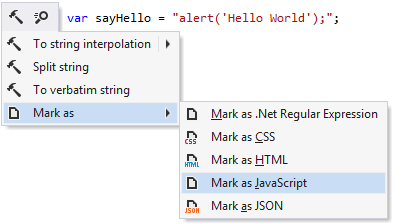
In addition, ReSharper now automatically injects languages in certain known scenarios, such as injecting JavaScript into AngularJS templates, or CSS in jQuery's$[]indexer. - Redesigned inspections severity options page (Code Inspection | Inspection Severity).
- ReSharper 2016.3 might now suggest you to use some of its features that can increase your productivity. In case it notices that some operation can be performed more efficiently, it would show a pop-up with a suggestion. You can enable the feature it suggests, read more about it, or disable further suggestions.
- New options page (Code Editing | Third-Party Code), which allows adding C++, JavaScript, TypeScript, CSS, HTML and JSON files, folders and wildcards to be treated either as "skipped" or "library". ReSharper will completely ignore "skipped" files, and treat "library" files as read-only indexed for navigation, but with no inspections, quick-fixes and refactorings.
- Assembly Explorer can now load assemblies directly from nuget.org or from any NuGet package source.
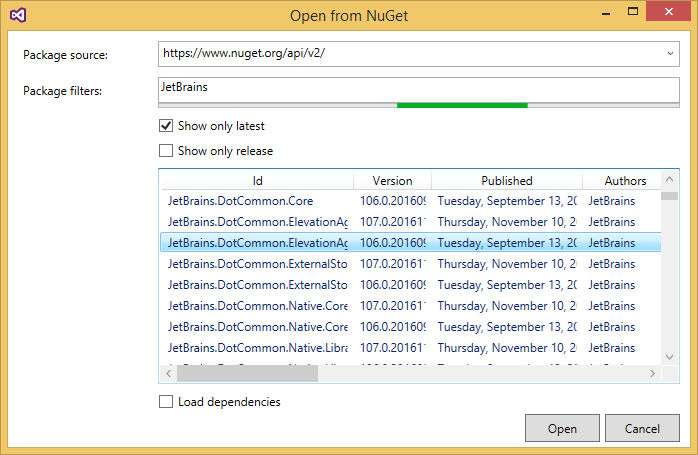
- Stack Trace Explorer now lets you open external stack traces faster: if you copy a stack trace that contains symbols from the currently opened solution and then switch focus to Visual Studio, ReSharper will automatically load it to the Stack Trace Explorer without the need of pressing any shortcuts.
ReSharper C++
ReSharper C++ 2016.3 comes with 180+ fixes and the following set of larger improvements:
- Visual Studio 2017 RC initial support: Just like the other tools in the ReSharper Ultimate family, ReSharper C++ 2016.3 can be installed into Visual Studio 2017 RC, but please note that in order to work with ReSharper C++ you should set Enable Faster Project Load to
falseunder Tools | Options | Text Editor | C/C++ | Experimental. - New typedef refactorings. The Introduce typedef refactoring allows you to quickly create a
typedeffor the selected data type and replace this data type and all its occurrences with the newly createdtypedef. The Inline typedef refactoring does the inverse: it replaces an existingtypedefwith the actual data type.

- Postfix completion and templates: Inherited from the mainline ReSharper, postfix code completion allows you to focus on your data, rather than the syntax. When you type a dot (
.) or an arrow (->) after an expression, ReSharper C++ will suggest free functions that would accept that expression as the first parameter. ReSharper C++ 2016.3 gets some postfix template goodness as well. You can now quickly wrap an expression with one of the following templates:if,else,while,do,return,switchandforeach.

- Catch support. In addition to Boost.Test and Google Test frameworks, unit testing assistance is now extended to support the Catch C++ test framework. Other unit testing improvements include support for Boost.Test in Boost 1.62 and improved performance on dynamic tests. Moreover, unit tests are now automatically updated for externally changed files.
- C++ code analysis from the command line. Starting from this update, ReSharper C++ code inspections are available via InspectCode, a free command line tool that allows running ReSharper C++ inspections without opening a solution in Visual Studio.
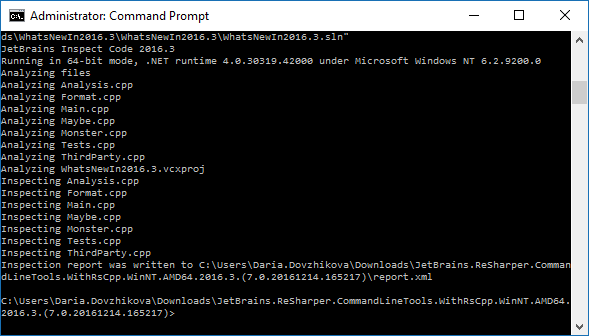
- Enhancements in Quick Documentation: ReSharper C++ 2016.3 can display rich, syntax highlighted tooltips for C++ code elements. The tooltips will display function and variable types, as well as documentation. C#-style XML documentation comments are also sometimes used for C++ symbols. With ReSharper C++ 2016.3 they are correctly displayed in the Quick Documentation pop-up (Ctrl+Shift+F1) and in the quick info tooltip.
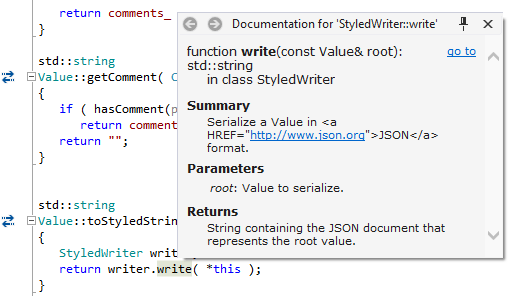
- Third-party code settings page now allows to exclude files from indexing, so ReSharper C++ will ignore "skipped" files, and treat "library" files as read-only.
- Support for nested namespace definitions introduced in C++17 and a context action to use the new syntax for nested namespaces.
- New options for C++ code formatter: "Spaces within parentheses in cast expressions", "Align chained method calls", "Align chained binary expressions" and "Place enumerators on new line".
Other tools in ReSharper Ultimate family also received their shares of improvements. First of all, dotCover 2016.3, dotTrace 2016.3 and dotMemory 2016.3 support .NET Core applications profiling and coverage and provide initial support for Visual Studio 2017 RC. Read on for the list of product-specific changes.
dotCover
- Reworked coverage highlighting: new highlighting engine in dotCover 2016.3 reveals both coverage status and unit test status. A marker in the text editor shows red if any tests related to the current statement are failing, green if all tests are passing, and grey if there are no tests covering this statement.
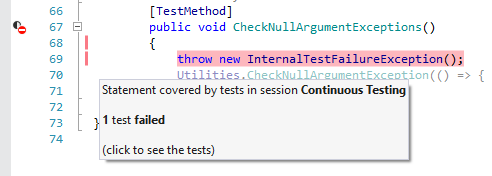
- New filtering options that allow easy selection of what code should be covered: all assemblies, everything except System and dotCover assemblies, or only solution assemblies without dependencies.
- Multi-selection for nodes in the coverage tree.
dotTrace
dotTrace 2016.3 provides a wide set of improvements for its Timeline Viewer, for instance:
- In dotTrace 2016.3, Timeline Viewer incorporates Subsystems feature from the Performance Viewer. To recap, each subsystem just groups calls made within a certain namespace or assembly. It is very handy for a quick estimation of how time in a particular call subtree is distributed among various components: user and system code, WPF, LINQ, collections, strings, and more.
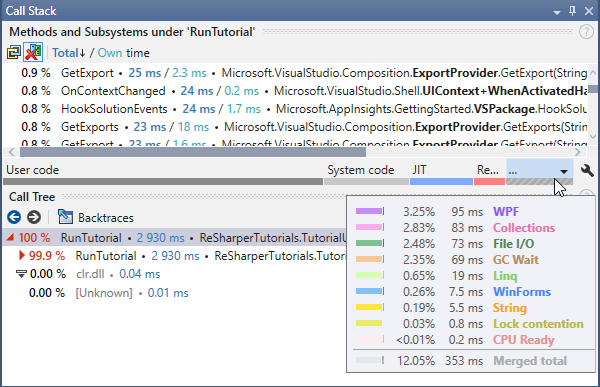
- New Debug Output filter that can be enabled to focus on what your application writes to the debug output, e.g. with the
Debug.Writesystem method. - The new Native Memory Allocation event filter allows you to see what methods are making the allocations and analyze all issues related to native memory: potential memory leaks, issues with unmanaged components used by your managed code, and others.
- The Call Stack window in dotTrace Timeline gets a whole bunch of enhancements in 2016.3. The Show system functions option that was helpful when analyzing methods’ own execution time is back again. The Top Methods list now shows not only methods own time, but total time as well. Moreover, now you can click on a method’s own or total time in Top Methods or Call Tree. This will apply a filter by a corresponding method or by a method and its subtree. The Top Methods list now follows your selection in Call Tree.
In addition there is a new Events window that shows you a list of events occurred in the profiled application: file operations, JIT, SQL queries, and more. Selecting an event will give details of the event, including timestamp, duration and call stack:
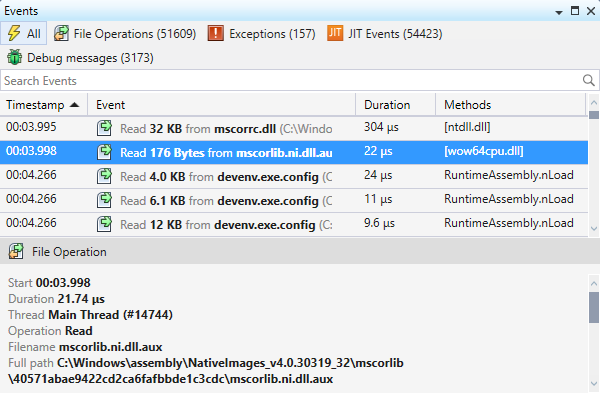
dotMemory
dotMemory 2016.3 adds new inspections to check your application on finalized objects and objects queued for finalization. A new Finalizable objects inspection on the overview page shows such objects sorted by their type.

dotPeek
dotPeek 2016.3 introduces new ways to explore metadata of .NET assemblies. You can now dig through all metadata items (tables, blobs, strings, etc.) right from the Assembly Explorer, which enables you to automatically find and display usages of metadata table items, decode and display values of blob items and explore PE file headers.
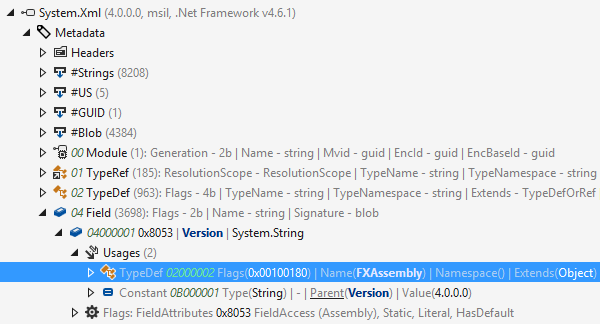
Same as elsewhere in the assembly tree, you can double-click metadata items to decompile and display the corresponding code.
Licensing
If you have an active subscription for ReSharper, ReSharper C++ or ReSharper Ultimate, we encourage you to upgrade to 2016.3 right away. If you are unsure whether your licenses are eligible to use with 2016.3, or if you need a formal quote or any other assistance, please get in touch with JetBrains sales anytime.
Subscribe to a monthly digest curated from the .NET Tools blog:









